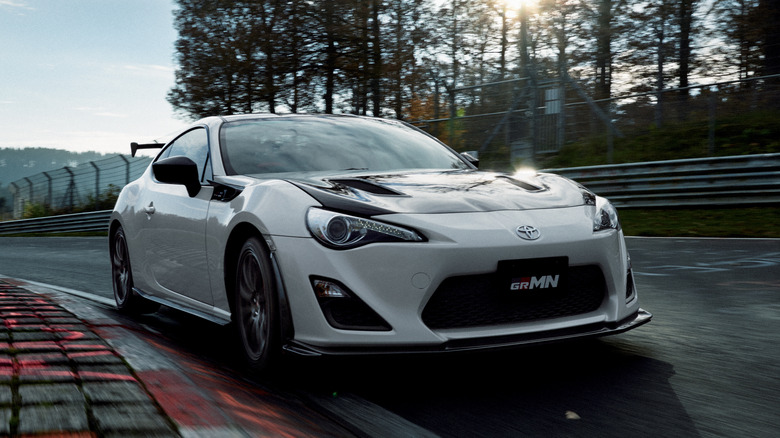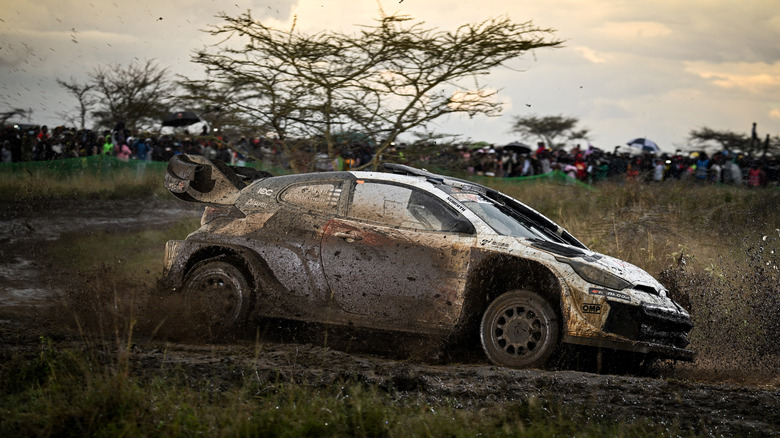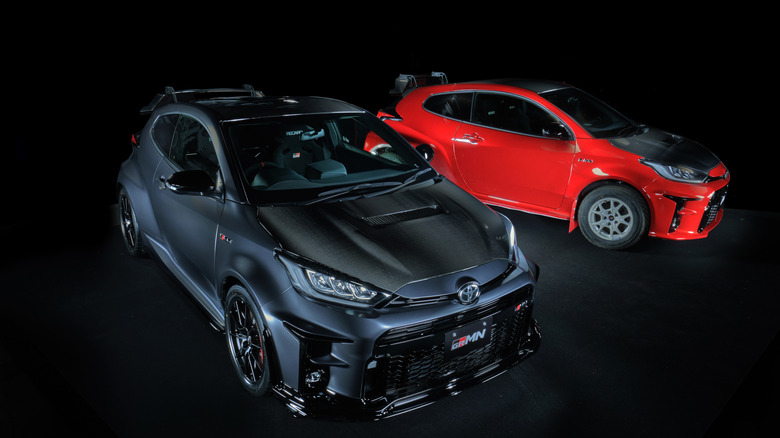What Does Toyota's GRMN Acronym Mean?
Among all the Toyotas on the road, the Gazoo Racing "GR" series represents an overwhelming minority, and the "GRMN" line a minority within that. These oddball, track-focused machines are seldom witnessed in the wild today, with Toyota almost always limiting their production runs to three-digit numbers. Moreover, only one model has ever appeared outside of Japanese soil, the GRMN Yaris sold in Europe. That all changed as of 2023, when the first spy photos surfaced showing Toyota's latest skunkworks project, the GRMN Supra. In March 2024, Best Car Web showcased the (tentative) specifications of this special-edition Supra.
With traction picking up, though, many of these enthusiasts are now asking one very important question: Just what is a "GRMN," anyway what sorts of expectations should one have concerning a GRMN-edition Toyota? Predictably, the first part stands for "Gazoo Racing," named after Toyota's motorsports arm. But here's where it gets interesting. The full name is actually, "Gazoo Racing tuned by the Meister of Nürburgring." How the acronym is pronounced generally varies from person to person.
The name "GRMN" inexorably ties into the very fabric of Gazoo Racing, the company itself tracing its roots back to the Nürburgring. In 2007, future CEO Akio Toyoda, under the pseudonym "Morizo," personally competed in the 24 Hours of the Nürburgring. The GRMN lineup honors this heritage through its tuning methodology, as the name implies, with each car utilizing the infamous circuit throughout its development. Let's take a closer look at how Toyota accomplishes this, and what to expect from a car wearing a GRMN badge.
A brief history of Gazoo Racing and the GRMN badge
GRMN's history traces its lineage back to Gazoo Racing's inception, being that the team originally cut its teeth on the Nürburgring. Headed by future Toyota president (later chairman) and racing driver Akio "Morizo" Toyoda, their first competitive debut featured a pair of used Toyota Altezza touring cars before evolving into standalone designs, with the team responsible for the Lexus LFA prototype and its own racing debut. That car's difficult undertaking occurred predictably at a subsequent 24 Hours of Nürburgring, namely 2009.
The "GRMN" name honors the legendary tuners who made these early successes possible, and thus propelled the "Gazoo Racing" division into the limelight. Since then, Gazoo Racing has expanded into multiple disciplines, generally revolving around long-distance or other extremely mechanically-demanding series. Highlights include the WEC (World Endurance Championship), Dakar, WRC (World Rally Championship), and Super GT.
Such a diverse and legendary racing history, coupled with a corporate head who's personally involved, naturally led to the development of a number of road cars, the GR series. However, these tend to be simply high-performance variants of standard Toyotas, or standalone sports cars like the GR Supra. To acquire the "GRMN" badge, so-equipped cars tend to blur the line between road and circuit more directly, featuring lightweight materials, stripped interiors, and so on. Basically, a GRMN Toyota is similar in philosophy to a Porsche 911 GT3 RS, in the sense that you're buying a fully-equipped track car right out of the box.
What specific GRMN models exist today, and what can you expect from a GRMN?
The two most well-known GRMN models are the GRMN 86 and Yaris, respectively. Both feature distinctive components exclusive to the GRMN lineup, such as bare carbon-fiber body panels and one-piece Recaro bucket racing seats. These tend to focus more on handling and weight than outright power, with GRMN-equipped cars not featuring any substantial power increases over their GR counterparts. For instance, a 2016 GRMN 86 only sports about 10% more power than a standard 86. Rather, a GRMN's strengths lie in its fun-factor. These cars are smooth, rev-happy, and highly-involved. A racing seat helps to amplify the subtle vibrations experienced through the road. The engines are tuned for long-distance circuit racing, and they all feature six-speed manuals — even the new GRMN Supra, supposedly.
Toyota produced four main models sold to the public so far, the first being a 2009 Toyota/Scion iQ city car, of all things. Subsequently, the company built a GRMN 86, Yaris/Vitz, and Mark X — none of which made it to the U.S. As for the upcoming Supra, publications speculate that it may share the same power plant as a BMW M2 and feature aerodynamics inspired by the GR Supra GT4 race car. And, just like its fellow GRMN Toyotas, this Supra was indeed tuned at the Nürburgring. As such, this limited-production Supra likely represents the closest thing the public can purchase that's a literal GT4 racer with a finished interior and air conditioning. And considering the track record (pun intended) of prior GRMN-badged Toyotas, the future looks bright for this rather unique, if quite rare, Toyota lineup.


